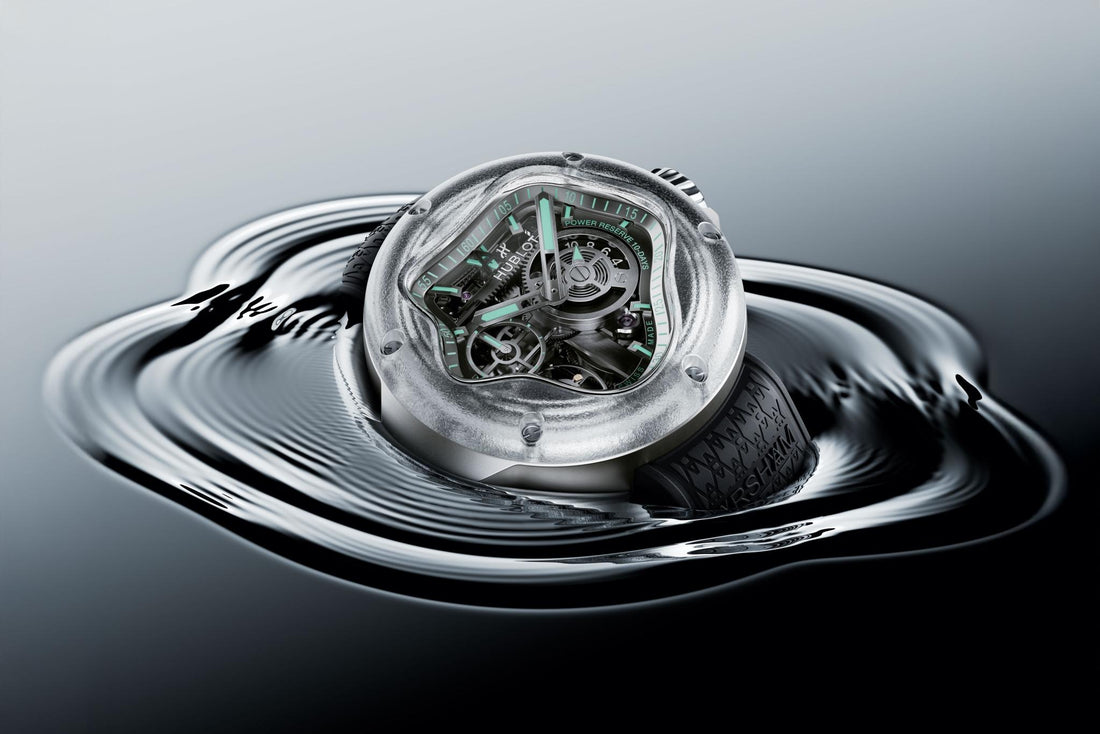Hublot, a brand known for its unapologetic commitment to the "Art of Fusion," has once again pushed the boundaries of horological design with a striking collaboration. They’ve teamed up with American visual artist Daniel Arsham, a creator whose work often plays with the very concept of time, blurring the lines between past, present, and future. The result of this partnership is the Hublot MP-17 Meca-10 Arsham Splash Titanium Sapphire, a timepiece that challenges conventional aesthetics and provokes contemplation about the future direction of watch design. It’s a piece that demands attention, but it also invites a closer, more thoughtful inspection.

Daniel Arsham's Signature Aesthetic Meets Hublot Engineering
Daniel Arsham is no stranger to high-profile collaborations, having lent his distinctive touch to brands spanning fashion, art, and even sports. He is an artist whose creations evoke a sense of "future relics," making objects appear as if they have been unearthed from a distant archaeological dig. This unique perspective is powerfully translated into the design of the MP-17 Meca-10 Arsham Splash.

The watch is a fascinating evolution of the artist's previous collaboration with Hublot, the Arsham Droplet, a non-wearable time-telling objet d'art. Now, that watery, fluid design language has been seamlessly integrated into a wristwatch. The core inspiration is flowing water, an element that naturally represents the passage of time, but also its ephemeral nature. The timepiece isn’t just a device for telling time; it is a wearable piece of sculptural art.

The fluid, organic lines are immediately apparent, transforming the typically rigid geometry of a watch case. The frosted, box-shaped sapphire bezel is where the artistic vision truly comes to life, featuring lines that mimic the movement of water. This isn't simple decoration, but a merging of technical mastery with an artistic form that requires considerable precision to execute.
A Design That Disrupts: The Splash Opening
Perhaps the most arresting feature of this timepiece is the splash-shaped opening for the dial. It's a natural progression from the droplet motif seen in other Masterpiece (MP) watches, but here, it feels more dynamic, more organic. This shaped dial opening creates the illusion of a large drop of water having frozen mid-splash atop the watch, an almost trompe l'oeil effect. You might find yourself wondering if it's about to slide right off the wrist.

The compact 42mm diameter case serves as the canvas for this artful disruption. Crafted from microblasted titanium with the laser-textured sapphire bezel, the material choice offers durability while maintaining a lightweight feel on the wrist. This balance of robust materials and delicate, flowing design underscores the collaborative spirit of the piece, blending Arsham’s fluidity with Hublot's engineering prowess.
Adding a vibrant jolt of the artist's identity are the green accents. This signature "Arsham Green" is strategically placed on the hour and minute hands, numerals, hour and five-minute markers, the small seconds hand at 9 o'clock, and the power reserve indicator at 3 o'clock. These details stand out vividly against the open-worked dial with its microblasted finish and rhodium plating.

But for all its artistic flourishes, the watch is still fundamentally a Hublot. The six H-screws on the bezel and case back, the distinctive lugs at 3 and 9 o'clock, and the titanium H-shaped folding clasp firmly anchor the design within the brand's established aesthetic. The MP-17 Meca-10 Arsham Splash is thus a balanced symbiosis; it is not merely a watch with an artist's logo, but a true fusion where both identities remain distinct but complementary.

The Engine Room: Hublot's Meca-10 Caliber
Beneath the artistic exterior beats a formidable, in-house movement, the Hublot Meca-10 (HUB1201). This is a manual-winding caliber that has earned respect for its innovative architecture and impressive specifications. Given the skeletonized nature of the design, the movement is a key component of the watch's visual identity, visible from both the front and through the sapphire case back.
The Meca-10 is a Meccano-inspired movement, known for its construction that looks almost like a high-end, complex construction toy, but this playful appearance hides serious engineering. It operates at a frequency of 21,600 vibrations per hour (3Hz) and is built with 29 jewels. The standout feature, however, is the remarkable power reserve of 10 days (240 hours). This extended autonomy is indicated by a sophisticated, skeletonized display at 3 o'clock, a functional element that is perfectly integrated into the overall open-worked design.

The decision to use this particular movement in the Splash edition is significant. It ensures that the watch is not merely a design exercise; it’s a high-performing mechanical timekeeper. This commitment to both form and function elevates the MP-17 beyond a mere novelty and positions it as a serious piece of horology.
The Future of Watch Design: Looking Beyond the Archives
The Hublot MP-17 Meca-10 Arsham Splash Titanium Sapphire, limited to just 99 pieces and priced at EUR 69,000, is more than just an exclusive timepiece; it’s a statement about the direction of watchmaking design. It suggests that true innovation might not solely come from incremental improvements or revisiting archival models, but from bringing in fresh, outside perspectives.

You might be surprised to find that many of the genuinely design-forward independent brands, such as Urwerk, MB&F, and Ressence, share a common thread: their founders have backgrounds that extend beyond traditional watchmaking, incorporating industrial design, fine art, and graphic design. These creators benefit from an inherent lack of "tunnel vision" that sometimes plagues larger, more established houses.

This Hublot-Arsham partnership underscores the benefit of such external influence. It’s a bold move, and it's this willingness to explore new shapes and challenge perceptions that keeps the watch world vibrant and engaging. Whether or not you are a fan of the aesthetic, you must acknowledge the daring and the fresh perspective it offers. It forces a conversation, and in the world of high-end design, that’s precisely what drives progress. Hublot, with this piece, certainly provides food for thought; after all, who will lead us into the next era of horological design, if not those willing to look outside the established boundaries?
